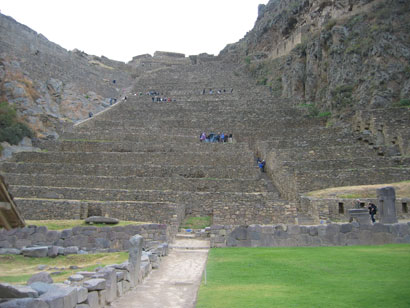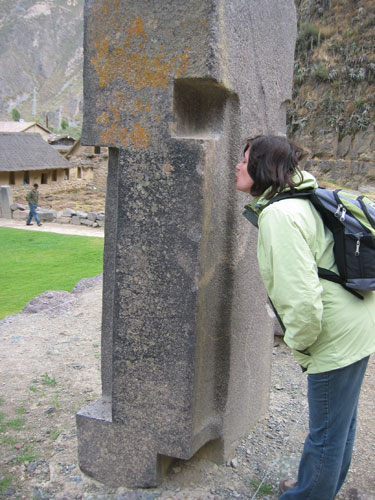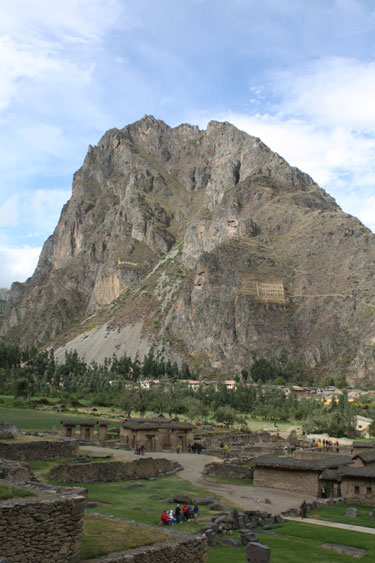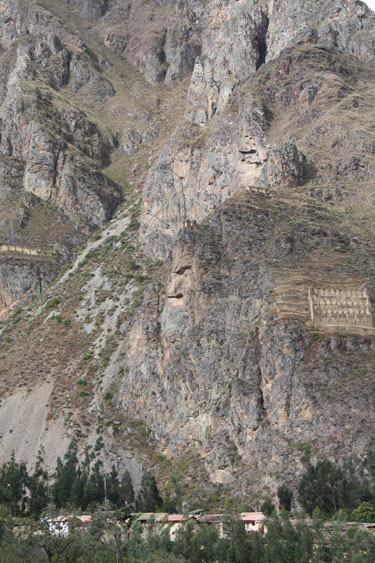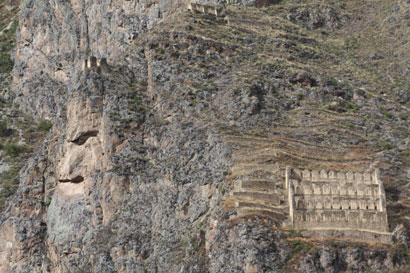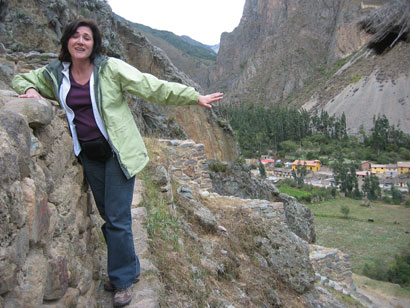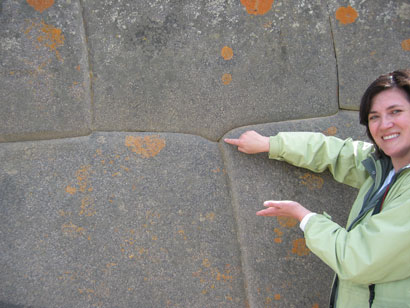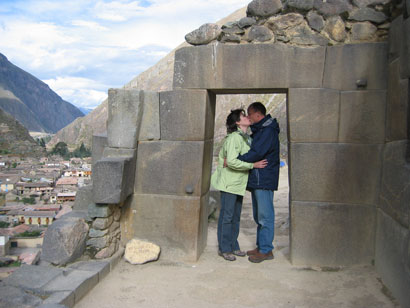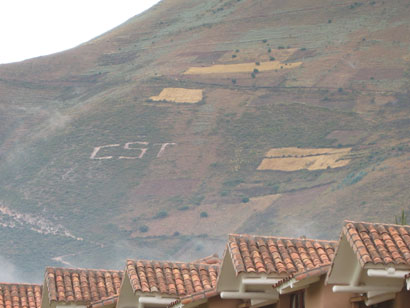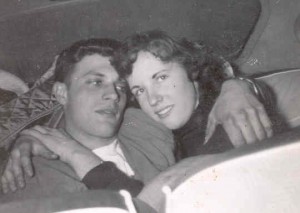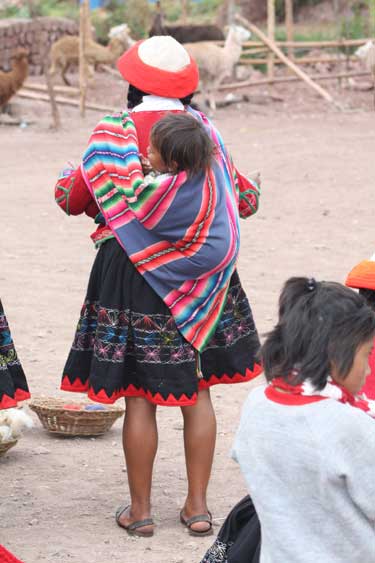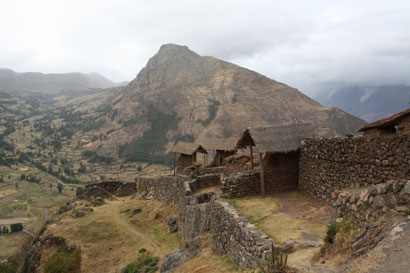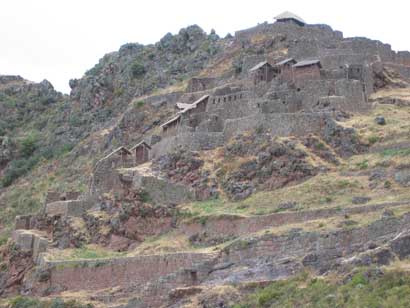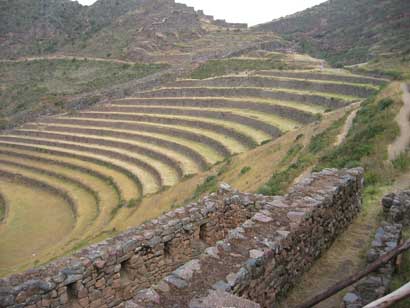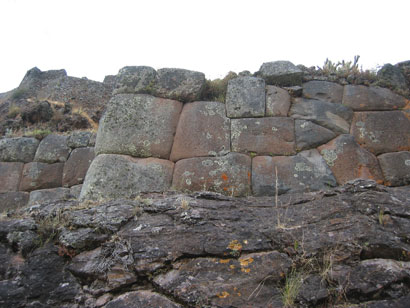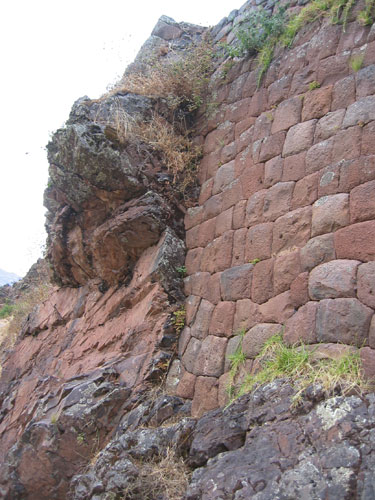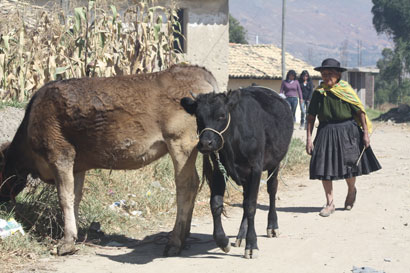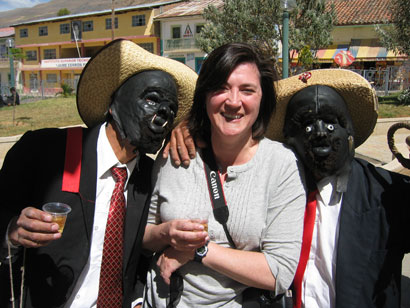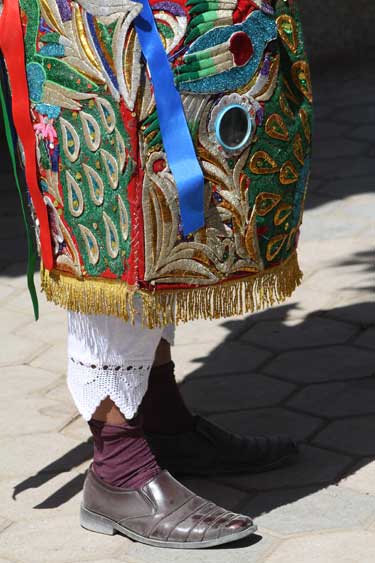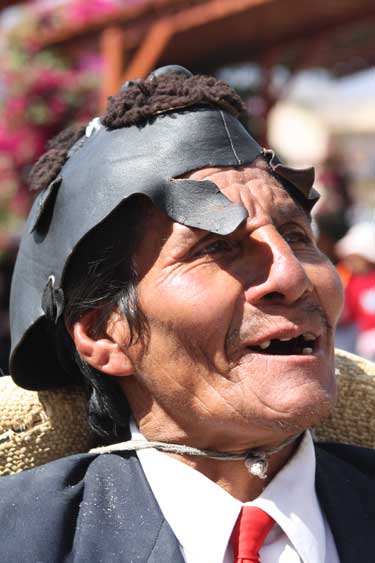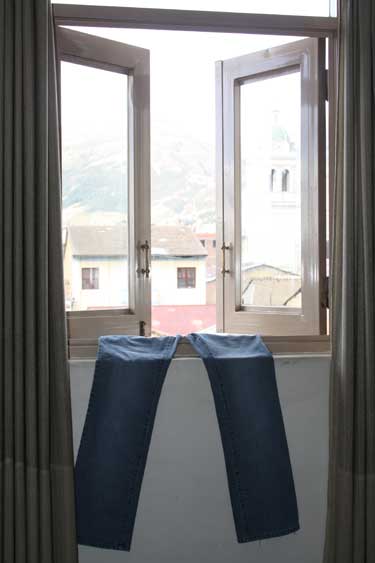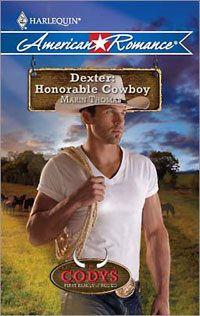Aguas Calientes, that is.
Ha ha, I’m so clever! (Not.)
Aguas Calientes is also known as Machu Picchu Pueblo, which basically means “town of Machu Picchu.” On Day 13 of our travels, we woke at our hotel in the Sacred Valley eager to get to the train that would take us to Machu Picchu. We had decided against hiking the Inca Trail. We’d actually decided this a year earlier while researching our trip. You can’t just decide to hike the Inca Trail on the spur of the moment, because it’s not something you can do on your own. You need to go on an organized tour, and only a certain number of people are allowed to begin the trek each day. Also, hiking the Inca Trail takes 3-5 days. That would have consumed a big chunk out of our 3 weeks. We most definitely would have been forced to chuck one of the four legs of our trip. I asked the DH during planning, and he didn’t seem to care about doing the trek. I cared. I didn’t want to do it! We were in a bad car accident 19 years ago this summer, and I’ve suffered neck and back and hip problems since. Honestly, I recovered from the car accident long ago. I didn’t have therapy of any kind for a solid year. But then I started writing consistently…and of course I aged (it’s a curse). I presently go to massage therapy every other week so I can do things like paint the deck and run with the dog and work at a computer. I couldn’t imagine hiking the Inca trail without my very own personal massage therapist!
Pre-car accident, I would have done it. However, I was younger than 30 pre-car accident, too. I like to think that pre-40 I would have wanted to hike the trail, too. But who am I kidding? I’m not an athlete! And I thought that people carried their own packs on the trail. They don’t. Peruvian porters carry the tents and food, etc. The porters set up camp and cook for you. The trekkers carry their cameras or whatever else they want in small day packs. Typicaly, in Canada, this is not one’s idea of “hiking” a trail. Or so we liked to tell ourselves whenever we overheard others congratulating themselves on making the trek. Oh, yeah, carry your own stuff instead of making some little Peruvian guy do it and THEN we’ll talk. (Yeah, I know, sour grapes, because I’m decrepit).
We met many people in Peru who had hiked the Inca Trail, including a couple in their 60s. Cusco is at about 11,000 feet elevation. However, Machu Picchu is at about 8000 feet elevation. The trek goes up and down, up and down, and then you finally emerge with (if you want) a dawn view of Machu Picchu. However, watching the sun rise over Machu Picchu can also be tricky…because there are so many clouds drifting around the sanctuary. More on that in a bit.
The train to Machu Picchu takes about 90 minutes. The train crawls! It crawls because the scenery is so spectacular. It’s hard to take good scenery pictures out a train window, so you’ll have to take my word for it.
Because of the floods earlier this year, the train to Machu Picchu started further up the line than normal (they were still repairing the rails). At one time, it ran out of Cusco. In the mid-Seventies, my parents took the train from Cusco to Aguas Calientes. But now it’s faster to bus tourists to the train start point.
We were picked up at our hotel and driven to a shuttle bus in the new part 0f Ollantaytambo. The shuttle bus took us to the train station. From there, we caught the train.

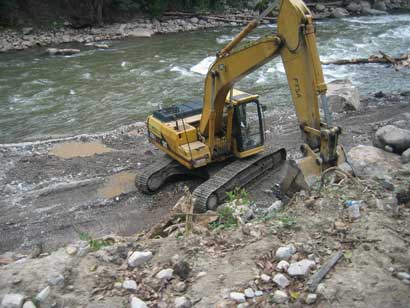

We reached Aguas Calientes without incident (no surprise floods!) and settled into our hotel, the very delightful Inkaterra Hotel. This place was like something out of Swiss Family Robinson. It was gorgeous. We had a very private room, the grounds were expansive, with a good restaurant (meals included, but not drinks), and birds and flora and fauna abounded. Honestly, we could not have afforded to stay at the Inkaterra if not for our tour, which included 5-star hotels (better price through a tour). Every other hotel we stayed in on this tour—in Lima, Cusco, and the Sacred Valley—was part of the Casa Andina Private Collection chain. That chain was…okay. The hotels themselves were very, very nice. But our rooms were the, um, bottom of the scale, shall we say, for 5-star hotels. I wouldn’t call the rooms themselves anything special. Except for at the Inkaterra. It was like a little piece of paradise to return to after a long day of walking around Machu Picchu (we did 8 hours of nearly solid walking).
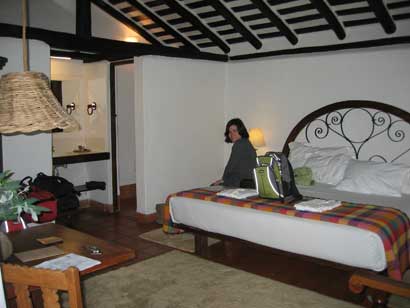
We had no idea that meals were included in the hotel cost when we arrived, so that was a pleasant surprise. As I’ve mentioned, drinks aren’t included, and if you’re a big drinker, you gotta watch out. Because when you check out of the Inkaterra, they tack on a hefty “donation” for the upkeep of the birds (which, honestly, could fly away if they wanted) and flora and fauna. The “donation” is a percentage of whatever you spent on booze and wine. The “donation” is voluntary, but you don’t know that if you don’t ask. If you receive your bill and are the type to just pay it without reading the fine print, you might think there’s no way out of this rather hefty surcharge. There is. You can choose not to donate…and feel like a cheapskate. We chose not to donate, because we had been leaving very nice tips and didn’t realize tipping wasn’t expected. We donated to our waiters instead of the birds and flora and fauna. I know, we’re bad.
To be honest, we gave the hotel a little extra. But not the 25% or whatever it was they tacked onto your bar bill.
I’m sure you can find your own Trip Tip! in there somewhere. I don’t have to spell it out for you, do I? Oh, all right.
Trip Tip! Read the fine print. Ask for translation of the fine print if necessary. Go ahead and feel like a cheapskate if you’re not comfortable with the fine print. It’s okay!
After a very nice lunch, we rested and then walked into Aguas Calientes. It started to rain. It rained and rained. It rained like Oregon-coast rain. Yes, we were in the rain forest. It was pretty hard to miss. We were told that the rain was “unusual” for the time of year (3rd week of May). We did get a teensy depressed that our visit to Machu Picchu the following morning would be marred by rain. We borrowed umbrellas from the hotel and went to bed telling ourselves that at least we could check out the amazing Inca drainage systems (except we’d already checked them out at Ollantaytambo).
We had a meeting at around 7 in the evening with our guide. We told him we wanted to go to Machu Picchu early, so we could watch the sunrise. He assured us that the sun rise didn’t occur until 7 a.m., and besides, the first bus to Machu Picchu didn’t leave until 6 a.m. Truth be told, you can watch the sun rise earlier over Machu Picchu (just not in the specific location to which our guide was referring), but you had to be standing in line at the gates at something like 4 a.m. for the privilege. If you wanted to hike Huayna Picchu, the famous peak you’ll see in the photos below, you also had to line up at 4 a.m. When my parents visited Machu Picchu in the mid-Seventies, you didn’t have to get up at 4 a.m. and you didn’t have to stand in line. That’s because you were one of a handful of people there. Now, in high season (which was just coming up, luckily we missed it), there’s something like 3000 tourists a day. Peruvian Disneyland!
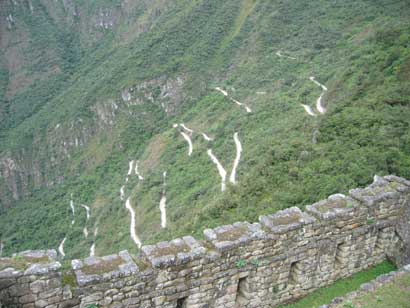
By the time we arrived at the gates to Machu Picchu (where you could show your passport and get a stamp, which made it feel even more like Peruvian Disneyland, but who cares?), the two groups had already been filled. We were a bit surprised to learn this…even though I’d been told by friends and had read about it. We’d hoped to be part of the 10 a.m. group allowed to hike Huayna Picchu and felt that our guide had fed us a bit of erroneous information, because his idea of “sunrise” and OUR idea of “sunrise” (i.e. it’s dark and then the sun rises) were two different things. HIS idea of sunrise was the sun had already arisen but hadn’t risen over a specific point at Machu Picchu. At first we figured the guy just didn’t want to get up at 4 a.m. to accompany us. In retrospect, he didn’t want to walk up that road that we traveled by bus! And I can’t say that I blame him.
But guess what? It wasn’t raining! It had started raining two or three days before we arrived in Aguas Calientes. We didn’t have a hot day at Machu Picchu, but we didn’t have a rainy, either. Considering we thoroughly explored the place for 8 hours with a very short lunch break (we had the guide for 2 hours and the rest we did on our own), we had the perfect weather. And the clouds were covering the guide’s version of the “sunrise,” anyway. So there. Even if we’d hiked up to the gates at 4 a.m., there was no sun to watch rise!

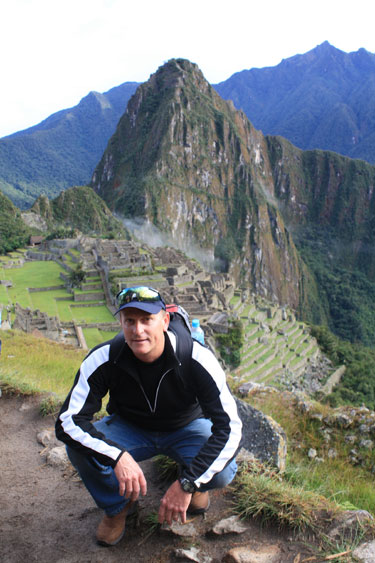
Another way to ensure you’re at Machu Picchu early is to stay at the Machu Picchu Sanctuary Lodge. It’s right outside the gates. It’s VERY expensive, and, honestly, with the number of tourists hanging around outside the Lodge (at the gates) all day long, I’m not sure how pleasant your stay would be. I’ve since talked to another writer who did stay at the Sanctuary Lodge specifically so she and her husband could watch the sun rise over Machu Picchu. But! The clouds covered the sun.
I’d stay at the Inkaterra and take the bus up the winding road again in a Peruvian minute.
Tons of pictures! But this post is way too long. We’ll get back to it next week. Adios!
